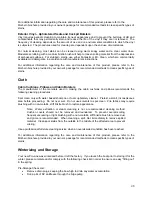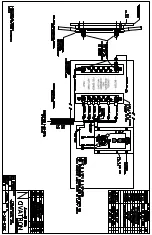
•
Drain all water systems, including the head, and pump an approved antifreeze through all
pumps, valves, drains and lines.
•
Fill fuel tank (3/4 – 7/8 full) and add a stabilizer/conditioner such as “STA-BIL” to the
gasoline.
•
Prepare engine in accordance with the engine manufacturer’s recommendations found in
your engine manual.
•
Treat metal parts with a rust inhibiter.
•
To prevent mold and mildew, use an absorbing product such as DampRid according to
the manufacturer’s directions. An alternative and inexpensive option is to fill egg cartons
with charcoal briquettes that have not been pre-treated with lighter fluid.
•
Remove batteries and protect them from freezing. Trickle charge overnight once a
month.
•
Place under cover. If the boat is stored on a trailer, loosen tie-down straps and place
blocks beneath axles to relieve the load on the tires.
For inboard/outboard engines only, to protect your boat during transport, the following procedures were
affected at the factory prior to shipping and will need to be rectified prior to launch:
•
Drain plugs on engine block removed.
•
Petcocks on engine removed.
•
Large hose on re-circulating pump removed.
•
Power steering cooler hose removed.
•
All other water hoses disconnected (left in place with hose clamps tightened to prevent
their loss).
Fitting Out After Storage
•
Check entire fuel system for loose fittings, leaks and damage.
•
Clean battery terminals; install battery(s), and coat terminals with a deoxidizing agent.
•
Check all thru hull fittings and hoses for obstructions, water tightness and condition.
•
Test all lights for proper operation.
•
Check wiring, terminal blocks and plugs for loose connections and corrosion.
•
Verify switch and equipment operation.
•
Check line condition. Inspect anchor and rope.
•
Clean out any debris from bilge and cockpit.
•
Flush water systems.
•
Install hull drain plug.
•
Verify operation of equipment before leaving dock.
Resealing
In the heat and sun, silicone and sealant can degrade over time. We recommend that you reseal around
everything that comes in contact with the deck or hull with a high quality silicone such as 3M 5200 sealant
annually. This includes but is not limited to the following:
Hatches on the top cap
Windlass
Port
lights
Windshield
Mid berth cabin window
Bow and transom eyes
Cleats
Clam shell at the anchor locker
Bow rail stanchions
Thru hull fittings
Hard top stanchions and supports
Dive ladder
Grab
rails
Outriggers
Rubrail
Motor
mounts
Access and other hatches
Cabin door
49










































